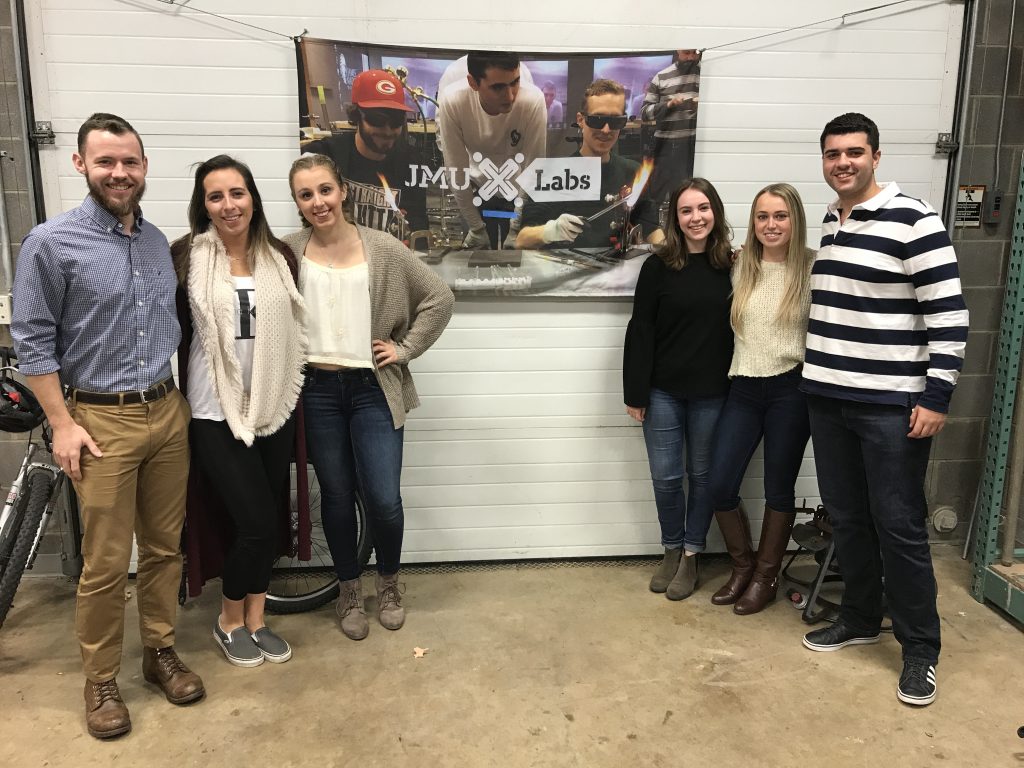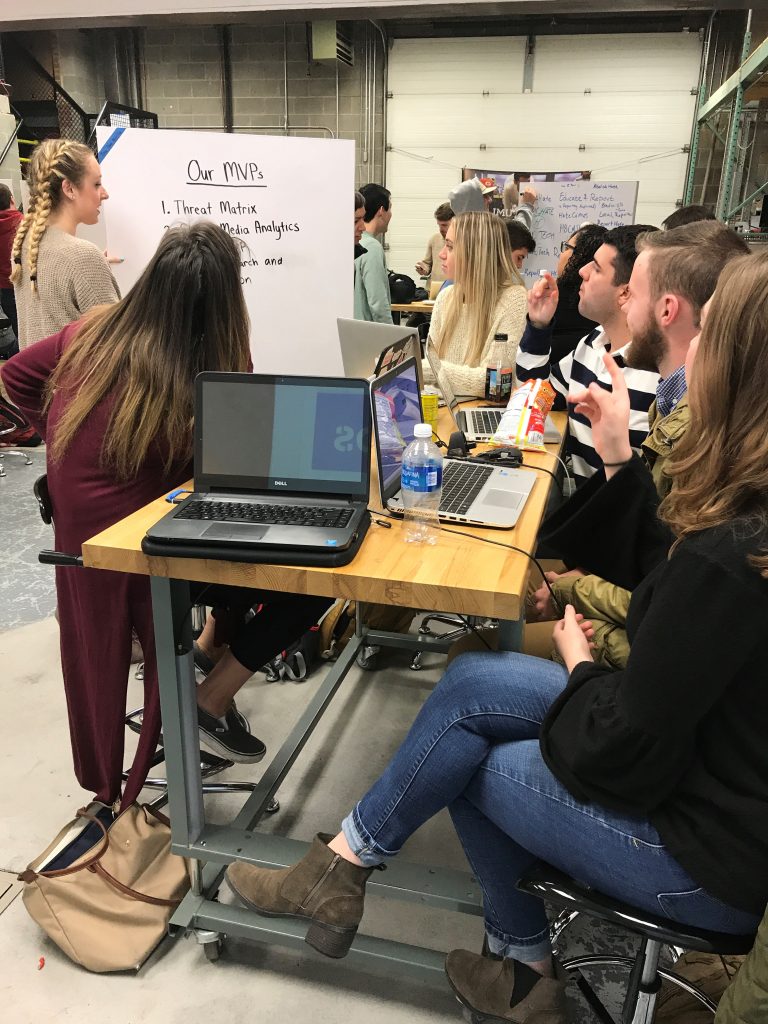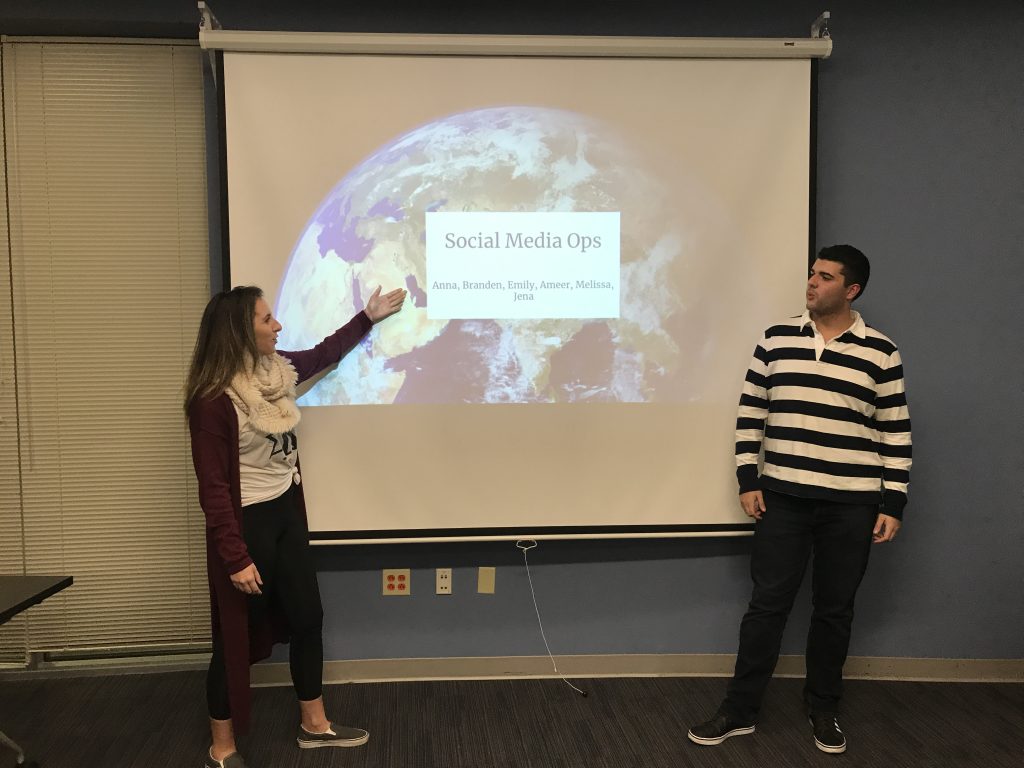Weekly Updates
Scroll below to see our progress throughout the semester retroactively. The most recent posts will be first, so have fun travelling back in time!
Hacking Social Media Escalations
What problem has SOCOM challenged us with solving?
Our team, Social Media Ops, has been working with the United States Special Operations Command (SOCOM) this semester on a social media escalation problem. Our sponsor has tasked us with creating a way to monitor information warfare on various social media platforms, with a special focus on social unrest in North Africa. We have been asked to create an early detection system that monitors unrest and threats on social media using trigger words, hashtags, geospatial recognition and various other features to prevent conflicts, radicalization of individuals and threats to nations as a whole. We have also been tasked with configuring a way to use social media analytics to develop counter-narratives toward protagonistic and antagonistic messages. A solution would empower SOCOM, as well as their teams internationally, to monitor and mitigate threats at a global, national and local level to better serve and protect people around the globe.
What is SOCOM and who is our mentor?
SOCOM is an organization within the Department of Defense that oversees a multitude of Special Operations branches within the various military branches. Their headquarters is located at the MacDill Air Force Base in Tampa, Florida. Their main responsibilities include: developing special operations strategies, monitoring the special operations assignments, personnel, education, retention and acquiring the equipment, materials, supplies and services to carry out missions. They provide combat-ready forces for rapid reinforcement of other unified commands worldwide. Our SOCOM mentor’s names and titles shall be kept anonymous for confidentiality reasons, however, they work within a branch that focuses on countries in North Africa. Our JMU mentors include LTC. Nick Swayne, director of the JMU X-Labs who served in the U.S. Army Psy Ops, and Dr. Kathleen Moore, a professor within the Intelligence Analysis major at JMU. If you would like to read more about SOCOM, please visit their website here.
What research did our team conduct?
We began by interviewing Intelligence Analysis professors at JMU to learn about social media trends, predictive analytics, cyber intelligence and counter-messaging. This was our stepping stone into understanding how social media analytics works and how to monitor it. After interviewing representatives from government agencies including SOCOM employees (both former and present), the Department of Homeland Security, Booz Allen Hamilton, a Political Officer at a US Embassy and a Political Communications Director for the United States Congress, we gained more background information about the scope of our problem and the nature of information warfare as well as tasks of political analysis in international affairs.
Our later interviews focused on the culture and technology in North Africa, as we believed that it was essential to understand the region, culture, and threats that individuals face. We interviewed the Program Director at EdVenture Partners who manages the Peer to Peer program conducted with international students. These students created social media campaigns and counter-narratives to threats in their home countries. To read more, click here. We heard personal insights on their regions and our current approach to solving our problem. We also interviewed an Imam who had personal experience in Sudan.
Our final interviews included a JMU employee who specialized in social media analytics/tracking of posts at JMU, a team from the Extremely Together Initiative at the Kofi Annan Foundation, which created a campaign on preventing and countering violent extremism around the globe, a CNN reporter with extensive field experience and the social media analytics companies Babel Street and Convergent AI, who track and gather social media data for assessment and predictive analysis. Overall, we conducted 36 total interviews with 32 different individuals.
Major Pivots:
Originally, we had a broad problem statement that was left up to interpretation. We quickly reached out to SOCOM for clarification to narrow our research, and were tasked with a focus on North Africa. This drastically shifted our approach, considering a rural community in the United States is different than one in Africa. We speculated how to identify these communities, monitor their social media, and effectively help SOCOM push their agenda.
Our initial plan was to create a social media analytics platform capable of searching social media for threats with trigger words, specific users, and geographical locations. We questioned our ability to actually create this type of program. Thankfully, Dr. Moore informed us that there are actually several companies that already have these capabilities. We decided to suggest a partnership between SOCOM and an existing platform. We discovered that SOCOM is already partnered with Babel Street. Rather than suggesting that they just extend their partnership, we decided to still include Convergent AI in our report because they possess a unique early detection capability for predicting terrorist attacks.
After interviewing several government agencies, we had an ah-ha moment that rather than just focusing on the social media monitoring of countries, we needed to focus on a topic that could be tracked through social media, such as a social movement, and assess how they arise, progress and the resolutions that follow. The predictive functions of a social media analytics tool could search trigger words that correlate with unrest or threatening posts, and monitor the social movement. We decided to create our own threat matrix of social movement progression. We researched social movements around the globe and in our region of focus to assess the premise of this matrix at a global scale and avoid bias in our research.
After another meeting with Dr. Moore, we were introduced to the idea of using bots to tackle counter-messaging. Previously, we considered providing educational tools on preventing extremism to rural communities to help them create their own counter initiatives and messages. This revelation on bots appeared to be a more effective way to monitor threats.
Our Final MVPs (Minimum Viable Products)
The research combined led to the creation of our three final MVPs. A minimum viable product is the simplest prototype possible. It is developed quickly, inexpensively, efficiently and is used to test a hypothesis in order to best understand the intended user’s interest. Our first MVP suggests a partnership between SOCOM and our suggested social media analytics platforms. Since Babel Street is already partnered with SOCOM, we believe that their contract could be extended to our sponsor’s branch to help them track/ gather data on all social media platforms. However, since Babel Street doesn’t have the ability to perform early detection, we are also suggesting that SOCOM partners with Convergent AI, since they possess an early detection system. An early detection system would detect a social movement before it occurs, which could help to avoid conflict and send effective counter-messages.
Our second MVP is our threat escalation model. It includes the four stages of a social movement which we define as: Dissatisfaction, Manifestation, Formation and Implications. This is based upon what we found studying sociology textbooks; however, we made our own modifications. We added indicators of the stage on social media and transitions that explain signs that a social movement is in a certain step and when it is phasing to the next step. Additionally, we included examples of social movements from several countries to provide a better understanding of how social movements evolve and how they could fit into our model.
Our final MVP is an explanation of bots and their capabilities. Bots are applications that perform automated tasks, such as googling information, ordering food and disseminating messages to large groups of people. They can be disseminated as automated messages, such as emergency amber-alert like notifications, or they can be user-friendly where the individual has the opportunity to navigate and interact with the bot to receive information and messages. Our group believes that bots would be an effective way to disseminate messages to the public in both urban and rural areas using social media, and that they could effectively respond to existing threats or monitor and prevent future threats.
The Value of an Interdisciplinary Team:
Our team is composed of six students whose majors span across seven different disciplines of study. This includes Intelligence Analysis, International Affairs, Public Policy and Administration (PPA), Engineering, Communications, Writing, Rhetoric and Technical Communication (WRTC), and Sociology. This versatility created a unique learning environment that has helped us complete our project more efficiently and strategically. The Intelligence Analysis and International Affairs majors are skilled in analytical terminology and a knowledge of the international conflicts we researched, which has been beneficial in creating our threat matrix and bot research. The PPA major possesses a thorough understanding of government structure and contributed multiple connections for interviewees within government agencies. Our engineer is skilled with using technology and piecing together the parts of our solution which was beneficial in finalizing our MVPs. The Communications major has refined public speaking skills, established strong relationships between our group members, and brought creativity to our team, which helped create a welcoming group atmosphere for ideas. The WRTC major brought strong editing skills for refining our writing submissions and, lastly, our Sociology major provided a skilled understanding of the way people interact and respond in social conflicts, which was beneficial in deciphering the best way to send a message to the public. These disciplines have created a strong, resilient team. We have been able to construct strategic, unique and intellectual ideas and articulate them efficiently to our audience, which ultimately made our group extremely successful throughout our journey.



